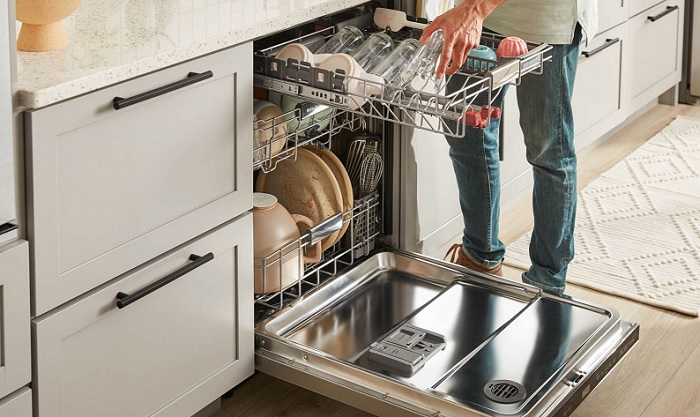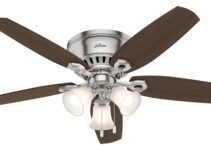If your KitchenAid dishwasher isn’t working, you might be dealing with a broken device. However, it could also mean that there is a software glitch or a slight malfunction that can be fixed with a simple reset of the dishwasher’s control panel.
Here’s a step-by-step guide to resetting your KitchenAid dishwasher and getting it to work again.

Kitchenaid Dishwasher Control Panel Reset Guide
- Make sure the dishwasher’s door is completely shut.
- Press one of these buttons: Hi Temp, Hi Temp Scrub, or Hi Temp Wash (choose one).
- Then, press one of these buttons: Heated Dry, Energy Saver Dry, or Air Dry (choose one based on your model).
- Press each button at least five times, alternating between the two buttons. This means you’ll press the first button five times, then the second button five times, and so on, until you’ve pressed each button a total of 10 times.
- As you press the buttons, you may see the lights above them activate or blink, and you might hear the dishwasher going through some self-diagnostic processes, like the drain pump running. Allow the dishwasher to complete these processes, which could take a few minutes.
- Once the dishwasher finishes, press the Cancel or Cancel-Drain button. This will start the drain cycle, which can last up to two minutes.
- After the drain cycle finishes, you should be able to start another dishwasher cycle.
If the dishwasher still doesn’t reset even after following these steps and checking the power supply, it means there may be a problem with the control panel’s computer board or the fuse might be blown. In such cases, it’s best to contact a service technician unless you have experience with this kind of repair.
Common Issues Requiring Control Panel Reset
Below, we will look at the issues that can arise with KitchenAid dishwashers and would require a control panel reset to fix.
1. Unresponsive Control Panel
Sometimes, the control panel of your KitchenAid dishwasher may stop responding, making it impossible to start or modify a wash cycle. This issue can occur due to temporary software glitches, power surges, or mishandling of the control panel.
To reset the control panel, you can follow the guide we have provided above, or just go read through this simplified version. First, find the circuit breaker that powers your dishwasher or unplug it from the electrical outlet.
Leave it disconnected for around five minutes before restoring power. This waiting period allows the dishwasher’s internal memory to reset, which would resolve the unresponsiveness.
2. Error Codes Displayed
Error codes appearing on the control panel can indicate specific malfunctions or failures within your dishwasher. These error codes may arise due to clogged filters, faulty sensors, water supply issues, or drainage problems
In some cases, error codes can be fixed with a control panel rest. To do this, begin by referring to the user manual that came with your dishwasher to identify the specific error code and its corresponding troubleshooting steps.
If a control panel reset is necessary to clear the error code, all you have to do is follow the same procedure mentioned above to reset the control panel.
3. Inconsistent or Poor Cleaning Performance
Your dishwasher may fail to clean dishes thoroughly or show inconsistent cleaning results. Insufficient water temperature, improper loading of dishes, clogged spray arms, or a malfunctioning wash motor can contribute to this issue.
To resolve this problem, start by ensuring that you load dishes properly, allowing for adequate water circulation. Check for any clogs in the spray arms and filters. If the problem persists, a control panel reset may help recalibrate the dishwasher’s settings and resolve performance issues.
4. Preventing Future Problems
- Regular Maintenance: To ensure optimal performance, perform regular maintenance tasks such as cleaning the filters, unclogging spray arms, and checking for any debris in the dishwasher’s interior.
- Proper Loading Techniques: Ensure that you load dishes correctly to allow for proper water circulation and avoid overloading, which can obstruct the spray arms and hinder cleaning performance.
- Use Appropriate Detergents: Select high-quality dishwasher detergents and follow the manufacturer’s recommendations to prevent residue buildup and enhance cleaning efficiency.
- Maintain Water Temperature: Confirm that your dishwasher’s water temperature is set appropriately. Lower temperatures may result in inadequate cleaning, while excessively high temperatures can damage delicate items.
- Power Surge Protection: Consider using surge protectors or voltage regulators to protect your dishwasher from power surges, which can potentially damage the control panel or other electronic components.
Conclusion
Knowing the common issues that can arise with KitchenAid dishwashers is important if you want to enjoy the value of the appliance. When you know how these problems occur, you can perform a control panel reset when necessary, which should help you efficiently troubleshoot problems and restore optimal functionality.





